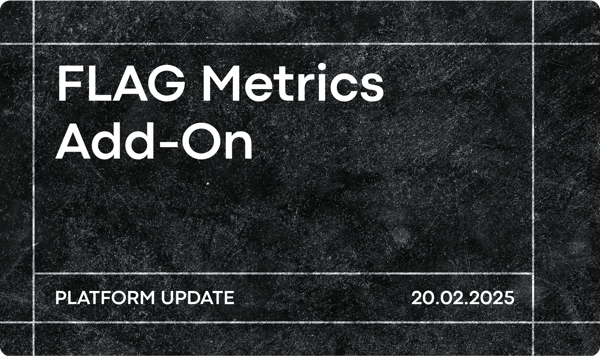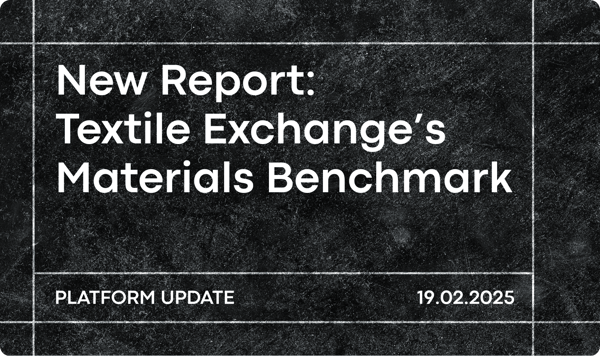With new European Union textile regulations like the CSRD, DPP, and CSDDD on the horizon, sustainability teams in the apparel and footwear industry face a growing challenge: balancing the need for meaningful decarbonization initiatives with the overwhelming demands of data collection and reporting.
The CSRD is set to dominate the agenda for sustainability teams over the next year, with companies previously subject to the NFRD having to report in 2025 using 2024 data. Adding to the complexity is 2028’s DPP, alongside another big acronym: CSDDD.
Gathering, organizing, and reporting data to meet the requirements of the European Green Deal can be time-consuming and complex. This blog guides sustainability teams trying to navigate the increasingly complex legislative landscape. The key goal for 2025? Staying ahead of compliance - without becoming a data administrator.
European Green Deal
The European Green Deal aims to make Europe the first climate-neutral continent by 2050 through a series of interconnected regulations. Together, these regulations require businesses to:
- Understand their environmental and social impacts (CSRD).
- Act on their findings to mitigate risks and improve ESG performance (CSDDD).
- Provide product-specific lifecycle data for transparency and circularity (DPP).
.png?width=2000&height=1144&name=6%20(3).png)
These regulations are connected and work together to cover every stage of a product’s lifecycle, from design to disposal. This means that brands need to have a holistic view rather than focus on each piece of legislation separately.
How to Approach Compliance?
In order to create an effective compliance strategy, it is crucial to take a holistic approach, keeping CSRD, CSDDD, and DPP (and other EU legislations) in mind together. The reason behind is that these regulations overlap significantly in their data requirements, making it possible to streamline efforts.
For example, CSDDD’s due diligence data often aligns with DPP’s product-level lifecycle information, while CSRD and CSDDD share a focus on company-wide emissions and carbon accounting. Therefore, you first need to zoom out and identify how multiple data elements can serve multiple purposes. See the data comparison between reporting requirements below:

Note: This is only an indication of DPP data requirements and a lot of the legislation is still subject to change.
Let’s take a look at each legislation!
Corporate Sustainability Reporting Directive (CSRD)
Current Status: Approved EU law
The Corporate Sustainability Reporting Directive (CSRD) requires companies to disclose detailed information about their environmental, social, and governance (ESG) performance.
Passed, voted, and implemented, it’s now translating into country laws, where the CSRD mandates that textile companies disclose non-financial information in compliance with the European Sustainability Reporting Standards (ESRS).
The ESRS provides a structured framework that standardizes how companies report to European regulators under the CSRD. By offering a clear, step-by-step methodology, the ESRS eliminates the need for organizations to devise their own reporting approaches, ensuring consistency. Learn more about ESRS here.
CSRD: Who Needs to Comply and When?
.png?width=2000&height=1144&name=5%20(2).png)
The CSRD applies to companies operating in the EU and, in some cases, non-EU companies with significant business in Europe. The implementation will be phased in over several years:
- 2025: Companies already covered by the Non-Financial Reporting Directive (NFRD) will report on their 2024 data.
- 2026: Large companies, including non-EU companies listed in the EU, will report on their 2025 data.
- 2027: Listed Small and Medium Enterprises (SMEs) will report on their 2026 data.
- 2028: Non-EU companies with at least €150 million in EU turnover and a subsidiary or branch in the EU will report on their 2027 data.
This phased approach gives smaller companies more time to prepare but also reflects the urgency for larger players to act.
CSRD: What Data Do You Need to Collect?
Compliance with the CSRD starts with understanding what is material to your organization. Materiality is assessed through a concept called double materiality, which evaluates impacts in two directions:
- Inside-out: The company’s impact on the environment and society. For example, water consumption or Greenhouse Gas emissions.
- Example: A ski apparel company assesses its Greenhouse Gas (GHG) emissions from production or water consumption in dyeing processes. These are ways the company impacts the climate.
- Outside-in: How external environmental and social factors affect your business’s operations and financial performance.
- Example: The same ski apparel company evaluates how reduced snowfall due to climate change could lower the demand for ski gear. It also considers how rising global temperatures could affect its sourcing of raw materials like wool or synthetic fibers, or disrupt its supply chain.
Some ESG topics are mandatory for all organizations, such as reporting on Greenhouse Gas (GHG) emissions, while others depend on a company’s specific materiality assessment. For instance, a water-intensive company must report its impact on water resources, while another might focus on supply chain labor practices. For apparel and footwear brands common areas include water use, waste management, chemical use, biodiversity, etc.
Digital Product Passport (DPP)
Current Status: Approved EU law
.png?width=2000&height=1144&name=4%20(1).png)
For apparel and footwear brands operating in the EU market, the Digital Product Passport (DPP) will be one of the most visible indicators of a company’s environmental performance. The idea behind this legislation is that every product in the future will be required to have a link (QR code or URL) that will showcase product details, likely including material composition, repairability, and others – though the specific criteria are yet to be defined.
In June 2024, the DPP was officially approved by the EU as part of the Ecodesign for Sustainable Products Regulation (ESPR), however, what is being discussed now by the legislators is which data points it will have to reveal about the product.
DPP: Who needs to comply and when?
The Digital Product Passport will be required for all apparel and footwear products, as well as products made primarily of textile materials, including leather. This applies to products sold on the EU market, regardless of where your brand is headquartered or the size of the company.
Here is the timeline for Implementation:
- 2024: The regulation was officially approved in June.
- 2026: Finalized data requirements for the apparel and footwear sector.
- 2028–2029: Full application for all products entering the EU market.

Subscribe to our Textile Regulations Hub to stay up-to-date on any news regarding the DPP and how it will impact your apparel and footwear brand.
DPP: What Data Do You Need to Collect?
While garments and footwear products currently already have a physical label that includes information such as material composition or country of origin—the new textile DPP will require more extensive reporting.
Although the final requirements for the DPP have not yet been published, we already have a general understanding, though it is hypothetical at this point. The information will probably be implemented in phases, gradually expanding over time.
This study conducted by the EPRS (European Parliamentary Research Service), published in June 2024, lists 16 categories of information that could be contained in the DPP:
.png?width=3840&height=2160&name=DPP%20(1).png)
Corporate Sustainability Due Diligence Directive (CSDDD)
Current Status: Approved EU law
The Corporate Sustainability Due Diligence Directive (CSDDD or CS3D) requires large companies to identify and address human rights violations (e.g., child labor) and environmental harms (e.g. pollution) across their operations, subsidiaries, and value chains.
Companies must take all necessary measures to identify, prevent, and mitigate risks while continuously improving their processes and performance year after year. The directive ensures an active, ongoing approach to sustainability, leaving no room for stagnation or maintaining the status quo.
CSDDD: Who Needs to Comply and When?
On April 24th 2024, the EU voted on the final directive text, and the CSDDD officially entered into force on July 25th. EU Member States have until July 26, 2026, to transpose the Directive into national law. Then compliance will be rolled out in phases:
.png?width=2000&height=1144&name=1%20(1).png)
CSDDD: What Are the Obligations for Your Brand?
The core due diligence obligations for companies in the scope of the Directive include the three following actions:
- Plan: Integrate due diligence into corporate policies and risk management systems
- Evaluate: Identify risks across operations, subsidiaries, and suppliers, prioritizing them based on severity and likelihood.
- Act: Prevent and mitigate risks that have been identified
Note that when severe adverse impacts persist despite all efforts, companies must suspend or terminate business relationships if the harm outweighs the consequences of disengagement.
To fulfill these steps, brands also have to:
- Engage with stakeholders (Note: for brands, these are mainly suppliers) at key stages of due diligence, especially when identifying impacts, by providing clear and detailed information to enable meaningful participation.
- Establish and maintain a complaints and notification procedure for stakeholders
- Track the progress by monitoring the effectiveness of due diligence measures
- Report on due diligence according to the CSRD and the ESRS
The Directive requires large companies (more than 1,000 employees and a net worldwide turnover of over €450 million) to develop and implement a climate transition plan to align with the 2050 climate neutrality goal of the Paris Agreement and intermediate targets under the European Climate Law. Companies must report progress and update the plan annually.
Fines must be at least 5% of the company’s global turnover, with the exact amount set by each Member State.
Find frequently asked questions about the CSDDD here.
Why Should You Start Preparing Now?
Starting early in 2025 is critical because compliance isn’t just about meeting deadlines—it’s about understanding the time it truly takes to prepare. Many brands underestimate how long it will take to gather the required data, build the right systems, and integrate new processes.
Take Scope 3 emissions reporting as an example. While larger brands may already have some data, the CSRD demands much more detailed and granular information, requiring a structured data collection strategy. For smaller brands, the process can take even longer if the data collection groundwork hasn’t been laid.
Starting now gives you the advantage of:
- Time to Build Systems: Set up a robust, scalable data strategy that works long-term.
- Collaboration: Align internal teams and supply chain partners without rushing.
- Continuous Improvement: Learn from the data, refine processes, and stay ahead of evolving requirements.
Measure Once - Report Everywhere
The issue we frequently hear from brands is that new reporting requirements are highly overwhelming, making it challenging to navigate regulatory hurdles without becoming trapped in endless administrative tasks. Instead of focusing on impactful decarbonization initiatives, many find themselves managing spreadsheets, chasing data, and preparing fragmented reports.
Our founders created Carbonfact with the belief that you as sustainability leaders should focus on decarbonization, not data administration. That’s why we’ve built a reporting software designed to streamline these processes.
One of the key insights we’ve uncovered is that while the CSRD and CSDDD focus heavily on full GHG scope emissions and company-wide reporting, the DPP requires product-specific lifecycle data. This can feel like separate and competing requirements - but they have a lot of overlap.
Our approach starts with product-level data, as required by the DPP. By gathering detailed insights at the product level, we create a foundation that can then be aggregated to meet company-level reporting needs for CSRD and CSDDD.
That’s where Carbonfact’s philosophy comes in: Measure once - report everywhere.
Step-by-step Approach
Here is a step-by-step process of how Carbonfact guides brands toward compliance:
- Gather data: We connect all your existing data sources - whether they’re in spreadsheets, PLM systems, ERP tools, traceability platforms or a combination of these all -into one centralized system, creating a single source of truth for your products.
- Clean your data: Using advanced data engineering and AI, we automatically identify and fill in gaps like component weights, textile thread density (dtex), or process-level steps, ensuring your data is accurate and reliable.
- Calculating LCA: Our Life Cycle Assessment (LCA) engine calculates environmental footprints for every product at the SKU level, following globally recognized standards like the GHG Protocol and PEFCR.
- Scale: To help you take meaningful action, Carbonfact identifies emission hotspots across your value chain. Instead of spending weeks figuring out where to focus, our system provides you with a prioritized list of supplier data to collect. Now, you can identify exactly where your emission hotspots are on a company-level, whether it’s specific materials, production processes, or particular suppliers.
- Report: Carbonfact automatically generates regulatory-ready reports to keep you compliant with CSRD, DPP, and CSDDD, saving you time and effort.
Watch the video below to see this all in action.









 Martin Daniel
Martin Daniel


-1.jpg) Laurent Vandepaer, PhD
Laurent Vandepaer, PhD